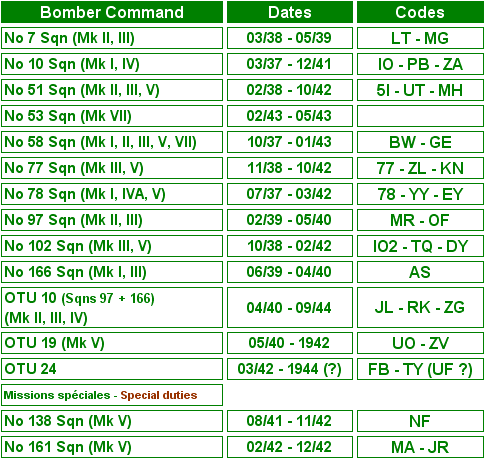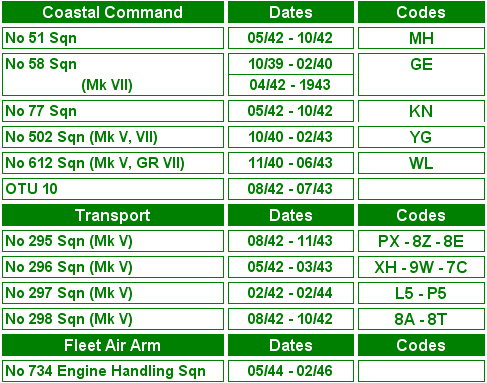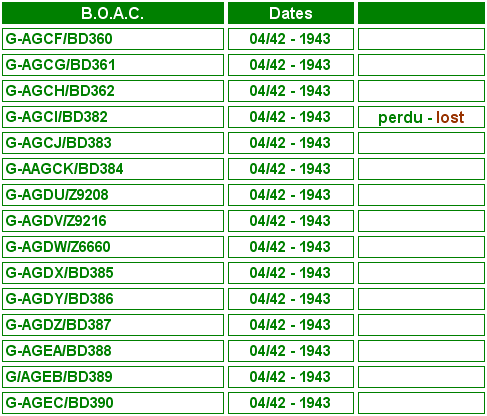Armstrong Whitworth Whitley
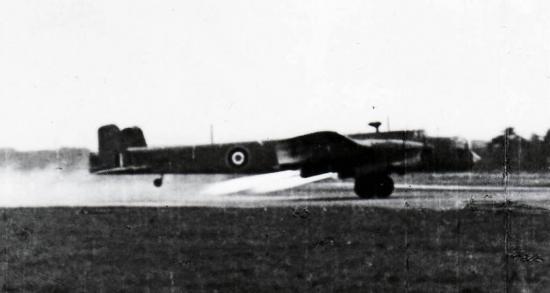
Armstrong Whitworth Whitley Mk V.
Au décollage avec des fusées d'assistance. Taking off with rocket pods assistance.
Source inconnue - Source unknown
Au Coastal Command - In the Coastal Command
Grâce à son rayon d'action important, des Whitley Mk V (dont certains furent équipés début 1941 du radar ASV Mk I) puis Mk VII (équipés fin 1941 de l'ASV Mk II) équipèrent progressivement des unités du Coastal Command : les No 58 Sqn (un détachement fin septembre 1939 à février 1940), No 502 Sqn (octobre 1940) et No 612 Sqn (mars 1941).
Thanks to its important range, Whitleys Mk V (some of them were fitted early 1941 with radar ASV Mk I) then Mk VII (fitted with ASV Mk II late 1941) were affected gradually to some Coastal Command units : the No. 58 Sqn (a section late September, 1939 to February 1940), No. 502 Sqn (October 1940) and No. 612 Sqn (in March, 1941).

Armstrong Whitworth Whitley Mk V (P5041), N° 502 Squadron
Aldergrove (Irlande), fin 1940 - Aldergrove (Ireland), late 1940
© Jean-Marie Guillou
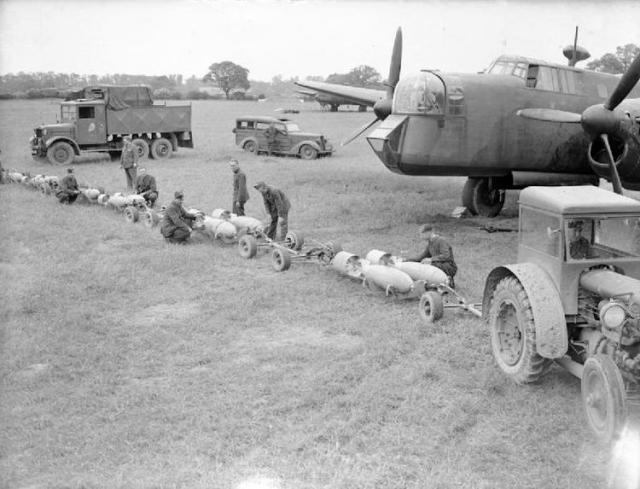
Armstrong Whitworth Whitley Mk V, No. 58 Squadron RAF, Linton-on-Ouse, Yorkshire.
© IWM (CH226) - www.americanairmuseum.com
A partir de l'automne 1941, le Coastal Command reçut des Mk VII. Différents Withley du Sqn 502 effectueront différentes attaques en octobre mais ce n'est que le 30 novembre que le Whitley Z9190 (code YG-B) coule le U-206 par larguage de 2 fois 3 grenades dans le Golfe de Cascogne (victoire reconnu après la guerre). Le U-206 avait été détecté par le radar Air-Mer. Cette victoire fut la première sans assistance navale pour le Coastal Command.
In the autumn, 1941, the Coastal Command received Mk VII. Some Withleys of Sqn 502 made various attacks in October but it is only on November 30th that the Whitley Z9190 (code YG-B) sunk the U-206 by dropping twice 3 grenades into the Gulf of Cascogne (victory recognized after the war). U-206 had been detected by the radar Air-Sea. This victory was the first one without naval assistance for the Coastal Command.

Armstrong Whitworth Whitley Mk VII - 612 Sqn
Source inconnue - Source unknown
Le 1er décembre, le Z9124 du Sqn 102 (P/O Cave) décolle de Limavady (Irlande du Nord), repère un sous-marin et le bombarde mais ne le coule pas. Mi 1941, des Whitley du Sqn 612 s'installent en Islande à Reykjavik pour mieux couvrir l'Atlantique Nord. Aucune victoire ne sera revendiquée lors de ce séjour et le Sqn 612 retournera au Royaume-Uni à Wick et intégrera le No 16 Group en février 1943.
On December 1st, the Z9124 of Sqn 102 (P/O Cave) took off from Limavady (Northern Ireland), located a submarine and attacked it but did not sink it. Mid-1941, Whitleys of Sqn 612 were affected in Iceland in Reykjavik to cover better the North Atlantic. No victory were claimed during this stay and Sqn 612 returned in the United Kingdom at Wick and integrated No.16 Group in February, 1943.
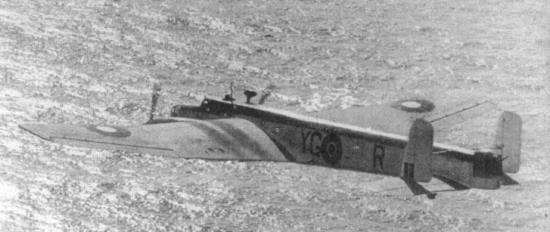
Armstrong Whitworth Whitley Mk VII - 502 Sqn
Source inconnue - Source unknown
Le Sqn 502, appartenant au No 15 Group, est basé à Bircham Newton (Norfolk) en février 1942. Le 14 avril, le Whitley "M" endommage le U-590 au large de l'Espagne. Le 23 juin, le Z9135 "C" du Sqn 58 endommage le U-573. Le 12 juillet, le Mk V Z9522 du Sqn 51 est abattu par des chasseurs. Le 17, le Whitley 'H' du Sqn 502 endommage gravement le U-751 qui sera coulé un peu plus tard par un Lancaster du Sqn 61.
The Sqn 502, belonging to No.15 Group, was based to Bircham Newton (Norfolk) in February, 1942. On April 14th, the Whitley "M" damaged the U-590 close to Spain. On June 23rd, the Z9135 "C" of Sqn 58 damaged the U-573. On July 12th, the Mk V Z9522 of Sqn 51 was shot down by fighters. On the 17th, Whitley 'H' of Sqn 502 damaged seriously the U-751 which was sunk a little later by a Lancaster of Sqn 61.
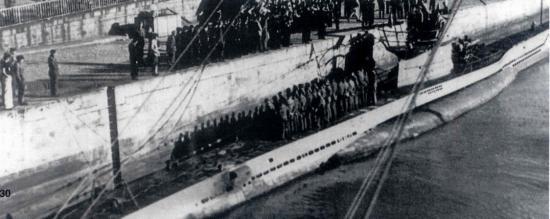
U-Boot U-751
Endommagé par le Whitley 'H' du Sqn 502 - Damaged by the Whitley 'H' of 502 Sqn.
Source inconnue - Source unknown
Le 1er août 1942, 16 Whitley de la 10 OTU sont affectés à St Eval. Le 3 août, le Z9119 du Sqn 51 est attaqué par des Arado Ar 196 : les mitrailleurs abattent un Arado mais le Whitley doit amerrir. Le 31 août, le U-256 sera attaqué d'abord par le Whitley 'B' du Sqn 502 vers 14h25 puis par le Z9144 'MH-O' du Sqn 51 vers 17h30 : le sous-marin, endommagé, ne reprendra la mer qu'en octobre 1943.
On August 1st, 1942, 16 Whitleys of 10 OTU were allocated at St Eval. On August 3rd, the Z9119 of Sqn 51 was attacked by an Arado Ar 196 : the machine gunners shot down the Arado but the Whitley had to land in water. On August 31st, the U-256 was attacked at first by the Whitley 'B' of Sqn 502 at about 2:25 pm then by the Z9144 'MH-O' of Sqn 51 at about 5:30 pm : the submarine, damaged, returned at sea only in October, 1943.

Armstrong Whitworth Whitley Mk VII Z9190 - 502 Sqn
Source inconnue - Source unknown
Le 3 septembre 1942, le Mk V 'P' Z6978 du Sqn 77 (F/Sgt MacInnes) coule le U-705 dans le Golfe de Cascogne. Le 15, c'est le GR Mk VII BD426 'Q' du Sqn 58 qui coule le U-261. A partir de l'automne 1942, les U-Boot allemands seront équipés de détecteurs de radar et ne seront plus repérés, les Whitley n'étant pas équipés du nouveau radar ASV Mk III non détectable.
On September 3rd, 1942, the Mk V 'P' Z6978 of Sqn 77 (F/Sgt Macinnes) sunk the U-705 in the Gulf of Cascogne. On the 15th, the GR Mk VII BD426 'Q' of Sqn 58 sunk the U-261. During the autumn, 1942, German U-Boots were equipped with radar detectors and were no longer located, and Whitleys were not fitted with the new radar ASV Mk III (not detectable).
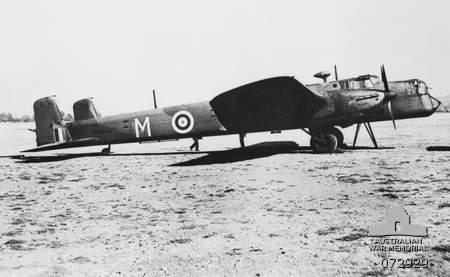
Armstrong Whitworth Whitley Mk VII - Coastal Command, 1942
Domaine Public - Public domaine (Picture with courtesy of Australian War Memorial)
Lors de l'opération Derange, organisée par le Coastal Command contre les U-Boot en Atlantique, le Whitley 'E' du Sqn 612 endommage le U-415 le 1er mai 1943.Le 3 ami, c'est le BD189 'K' de la 10 OTU qui coule le U-214 (victoire connue après la guerre). Le 24 mai, le BD414 'J' endommage le U-523. Le 14 juin, le BD220 'G' de la 10 OTU coule le U-564 (endommagé la veille par un Sunderland du Sqn 228) mais doit amerrir : l'équipage sera repêché par une bateau de pêche français et sera fait prisonnier.
During the operation Derange, organized by the Coastal Command against U-Boot in the Atlantic Ocean, the Whitley 'E' of Sqn 612 damaged the U-415 on May 1st, 1943. On May 3rd, the BD189 'K' of 10 OTU sunk the U-214 (victory known after the war). On May 24th, the BD414 'J' damaged the U-523. On June 14th, the BD220 'G' of 10 OTU sunk the U-564 (damaged the day before by a Sunderland of Sqn 228) but had to land in the water: the crew was rescued by a French fishing boat and was arrested.

Armstrong Whitworth Whitley Mk VII - No. 612 Sqn.
Reykjavik, Islande, mai 1942 - Reykjavik, Iceland, May 1942. De gauche à droite - Left to right :
RAF pilot George Totolos, RAAF Flying Officer Terry H. Gordon-Glassford, an unknown RAAF pilot, RAF Pilot Geoff Dobbie, RAF Observer Les Green, RAF Wireless Air Gunner (WAG) Bob Royle and RAF WAG Eldon Beale.
Domaine Public - Public domaine (Picture with courtesy of Australian War Memorial)
Fleet Air Arm
Un premier Whitley (Z9192) fut transféré à la F.A.A. pour évaluation en juillet 1942 puis 16 autres (ex Mk VII baptisés GR VII) en août afin dans la perspective de familiariser les mécaniciens naviguants aux moteurs Merlin et aux procédures de transfert de carburant. Suite à cette évaluation, des appareils furent affectés en mai 1944 au No 734 Engine Handling Sqdn (Worthy Down) et y furent utilisés jusqu'en février 1946.
A first Whitley (Z9192) was transferred to the F.A.A. for evaluation in July, 1942 and then 16 others (ex Mk VII renamed GR VII) in August in order to familiarize the flight mechanics in Merlin engines and in the procedures of fuel transfer. Further to this evaluation, aircrafts were allocated in May, 1944 to No. 734 Engine Handling Sqdn (Worthy Down) and were used there until February, 1946.
Utilisations spéciales - Special duties
Parachutage - Paratroops dropping
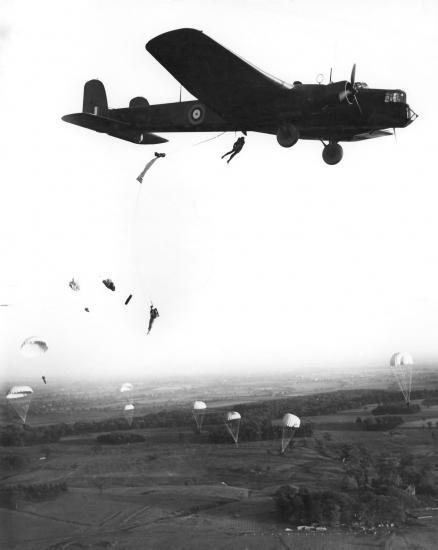
Armstrong Whitworth Whitley
Larguage de parachutistes - Paratroopers dropping
Photo : source inconnue - Source unknown
Après le succés des opérations aéroportées allemandes aux Pays-Bas et en Belgique, la No 1 Parachute Training School basée à Ringway (Manchester) est créée le 19 juin 1940 ; 6 premiers Whitley Mk II y sont affectés : la forme carrée de la queue du Whitley permet d'accueillir 10 hommes, l'emplacement de la tourelle arrière pouvant servir de plateforme et celui de la tourelle ventrale pouvant recevoir 2 portes battantes.
After the success of the German airborne operations in the Netherlands and in Belgium, the No.1 Parachute Training School based at Ringway (Manchester) was created on June 19th, 1940 ; 6 Whitley Mk II were allocated : the square shape of the Whitley tail allowed to welcome 10 paratroopers, the place of the rear turret served as a platform and the place of the turret below was replaced by 2 swing doors.
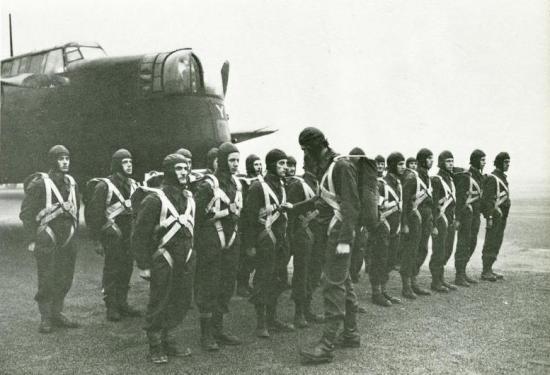
Paras à l'entraînement à Ringway devant un Whitley
Paratroopers during a training at Ringway in front of a Whitley
Photo : domaine public - Public domain (UK Government)
Les premiers essais de saut sont effectués en juillet : 2 instructeurs sautent par la plate-forme arrière et 6 par la trappe. Le saut par la trappe est retenu, non sans danger : 5 hommes placés à l'avant de la trappe sautent avec le vent relatif dans le dos mais les 5 placés à l'arrière sautent face au vent ce qui parfois provoque une mauvaise ouverture de la voilure.
The first tests were made in July : 2 instructors were dropped by the rear platform and 6 by the trapdoors. The jump by the trapdoor was prefered but not without danger : 5 men placed in front of the trapdoor jumped with the relative wind in the back but the 5 men at the rear jumped by facing the wind which sometimes provoked a bad opening of the parachute.
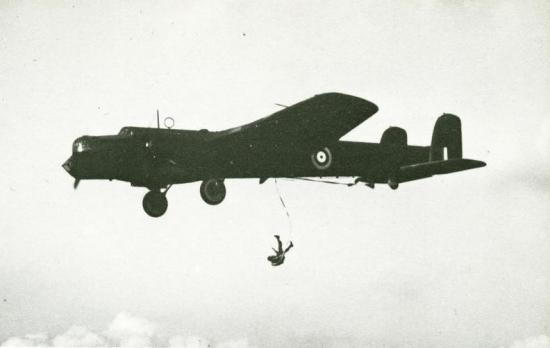
Parachutiste sautant d'un Whitley par la trappe ventrale.
Paratrooper jumping from the central trapdoor of a Whitley
Photo : source inconnue - unknown source

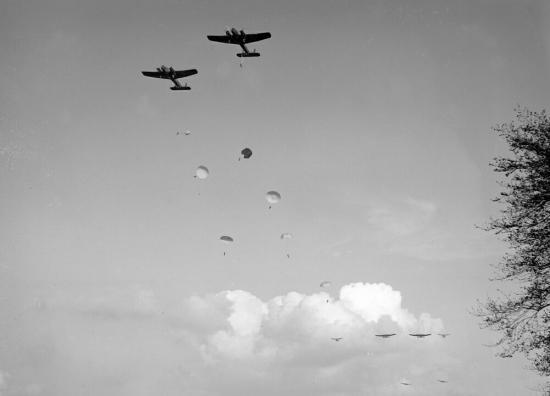
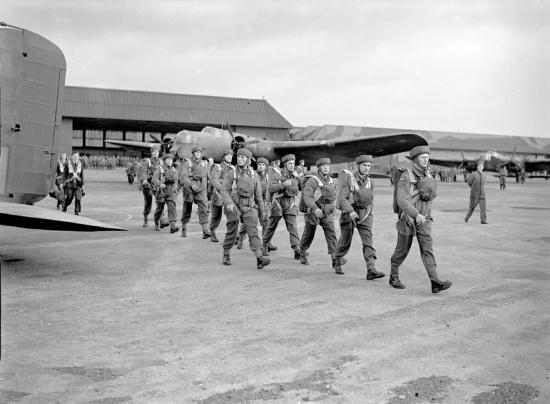
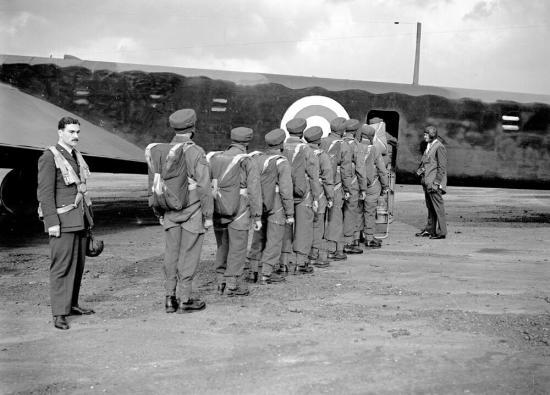
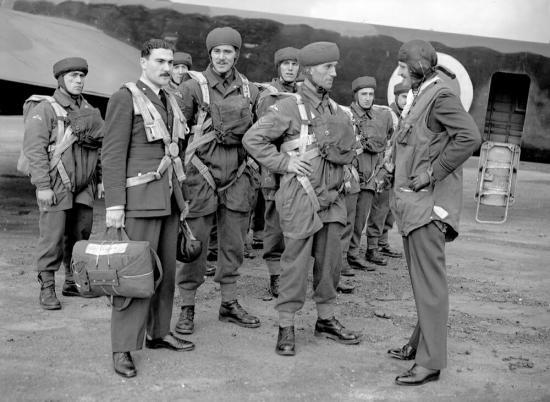
Ringway, octobre 1941, 4 photos de parachutistes à l'entraînement sur Whitley Mk V
(sur 4000 sauts, 4 parachutistes se tueront).
Ringway, October 1941, 4 pictures of paratroopers training with Whitley Mk V
(out of 4,000 drops, 4 paratroopers were killed).
© Flightglobal - Reed Business Information - www.flightglobal.com
Des Whitley furent même utilisés en opération :
- opération Colossus (février 1941) : afin de larguer une unité spéciale pour détruire le pont-aqueduc de Tragino (Italie) et ainsi priver d'eau les zones industrielles et portuaires de Brindisi, Bari et Foggia, 4 équipages sont sélectionnés dans chacun des Sqn 51 et 78 et envoyés à Ringway : ils s'entraînent sur des Mk II mais effectueront la mission sur des Mk V (pouvant emporter du matériel en plus des hommes). Les 8 avions sont menés le 3 février 1941 par le W/Cdr Tait à Mildenhall (Suffolk) et arrivant au milieu d'une alerte sont reçus par la DCA. 39 (ou 38) hommes du peloton X du 11e bataillon SAS (ex Commando No 2) les y rejoigent. Pilotes et soldats ne connaissent pas le but de leur mission. Le 7 février au soir, hommes et matériels décollent pour Luqa (Malte) en traversant la France et se posent le 8 sur une piste pleine de cratères de bombes.
Whitleys were even used in operation :
- Operation Colossus (February, 1941) : to drop a special unit to destroy the aqueduct of Tragino (Italy) and so deprive of water the industrial area and harbor of Brindisi, Bari and Foggia, 4 crews were selected in each of Sqn 51 and 78 and sent to Ringway : they trained on Mk II but made the mission on Mk V (for their capacity to carry equipment in addition to men). 8 aircrafts were led on February 3rd, 1941 by the W/Cdr Taits to Mildenhall (Suffolk) and arriving in the middle of an alert were received by the AA. 39 (or 38) men of the group X of the 11th battalion SAS (ex No. 2 commando) joined them there. Pilots and soldiers did not know the purpose of their mission. On February 7th in the evening, men and equipments took off for Luqa (Malta) by crossing France and landing on the 8th on a runway full of bombs' holes.
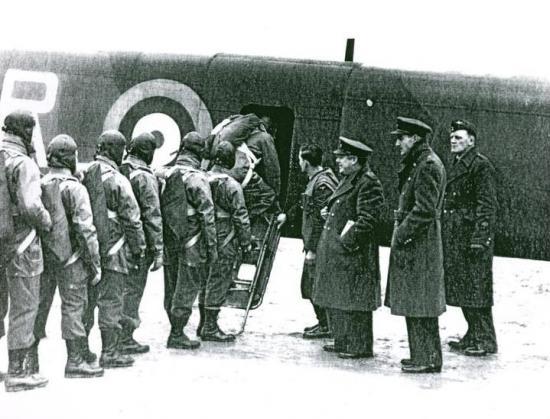
Embarquement pour Malte à board d'un Whitley - Boarding in a Whitley for Malta
Photo : source inconnue - unknown source
Le raid est lancé dans la nuit du 9 au 10 février : 6 Whitley sont chargés de 6 hommes et 6 conteneurs et 2 autres de bombes en vue d'effectuer un raid de diversion sur Foggia à 45 km de l'aqueduc. Finalement, un homme étant malade sur la piste, 35 hommes partiront menés par le Major Pritchard (7 officers et 28 hommes). 5 Whitley larguent leurs hommes près de la cible mais le 6°, perdu, largue les siens dans une vallée voisine. Les conteneurs de matériel ne seront pas tous largués pour des problèmes de gel de lance-bombes. Un des deux Whitley chargé de bombarder Foggia, le T4167, tombera victime d'une panne de moteur. Malgré quelques dégâts, l'aqueduc sera vite réparé. Le commando et l'équipage du Whitley seront capturés, le sous-marin Triumph chargé de les récupérer ne s'étant pas présenté.
The raid was launched in the night from 9th to 10th February : 6 Whitleys were loaded with 6 paratroopers and 6 containers and 2 others with bombs to make a diversion raid on Foggia at 45 km from the aqueduct. Finally, a man being sick on the runway, 35 men left led by the Chief Warrant Officer Pritchard (7 officers and 28 soldiers). 5 Whitleys dropped their paratroopers near the target but the 6th one, lost, dropped them in a nearby valley. The containers of equipment were not all dropped for problems of frozzen bomb launchers. One of the two Whitleys in charge of bombing Foggia, the T4167, fell victim of an engine failure. In spite of some damages, the aqueduct was rapidly repaired. The commando and the crew of the Whitley were captured, the submarine Triumph lin charge of getting them back never appeared.
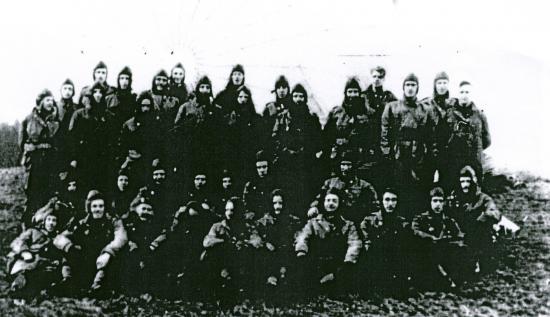
Les hommes de l'Opération Colossus (peloton X) - Men of Operation Colossus (X troop)
Photo : domaine public - Public domain (UK Government)
- opération Savannah (mai 1941) : à l'initiative du Cne Bergé et avec l'accord du Gal de Gaulle, une unité d'une trentaine de parachutistes de la France libre est créée en septembre 1940 dans le Kent puis est transférée en novembre à Ringway. Une mission leur sera confiée : attaquer un car d'aviateurs allemands de la KG 100 entre Vannes et Meucon (ces aviateurs étaient en charge du balisage des bombardements nocturnes). Le 14 mai 1941, 4 hommes (S/Lt Petit-Laurent, S/C Forman, Sgt Le Tac, C/C Renault) embarquent dans un Whitley piloté par le F/O Oettle du 419 Flight SD. Par manque de visibilité, les parachutistes sautent en retard avec 2 conteneurs à 8 km de la DZ (Drop Zone). De plus, le car attendu ne circule pas sur la route indiquée, les informations étant périmées, et la mission est un échec.
- operation Savannah (May, 1941) : on the initiative of Cne Bergé and with the agreement of the Gal de Gaulle, a unit of around thirty Free French paratroopers was created in September, 1940 in Kent and then transferred in November at Ringway. A mission was given to them : the attack of a bus of German airmen of KG 100 between Vannes and Meucon (these airmen were in charge of the identification of the night-bombardments). On May 14th, 1941, 4 men (S/LT Petit-Laurent, S/C Forman, Sgt Le Tac, C/C Renault) boarded on a Whitley flown by the F/O Oettle of 419 Flight SD. Due to the lack of visibility, the men jumped late with 2 containers at 8 km of the DZ (Drop Zone). Furthermore, the expected bus did not circulate on the indicated road, the information being obsolete, and the mission was a defeat.
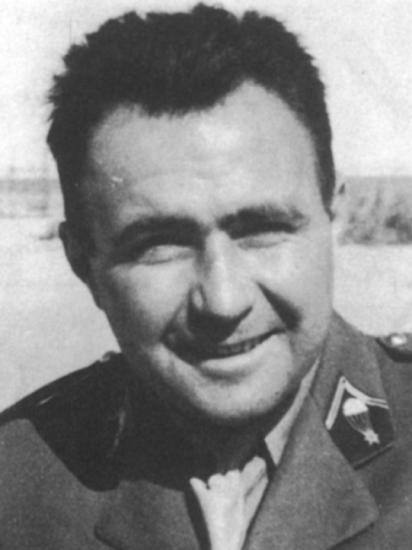
Capitaine Georges Bergé © www.france-libre.net
- opération Biting (février 1942) : capture d'une station radar Wurzburg complète sur les falaises de Bruneval (Seine-Maritime - France) par des troupes aéroportées. En janvier 1942, Lord Louis Mountbatten organise un raid de la 1ère division aéroportée pour capturer ce radar. Le 15 février, 113 hommes et 6 officiers effectuent leur dernier saut d'entraînement pour cette mission. Le 27au soir, ils embarquent à bord de 12 Whitley Mk V du Sqn 51 sur la base de Thruxton (Hampshire). Le W/Cdr Pickard commande le vol. Peu après avoir franchi la côte, les parachutistes du major Frost sautent et atterrissent dans la neige, à environ un kilomètre d'une villa très proche du radar. Ils capturent et démontent le radar mais leur évacuation sera retardée : le commando du Lt Charteris, chargé de prendre la plage pour embarquer, a sauté trop loin et mis plus de temps que prévu pour accomplir sa mission. Les parachutistes embarqueront néanmoins à bord de bateaux de la Navy mais laisseront 1 tué et 7 prisonniers.
- operation Biting (February, 1942) : the capture of a radar station Wurzburg on the cliffs of Bruneval (Seine-Maritime - France) by airborne troops. In January, 1942, Lord Louis Mountbatten organized a raid of the 1st airborne division to capture this radar. On February 15th, 113 men and 6 officers made their last training jump for this mission. The 27th in the evening, they embarked aboard 12 Whitleys Mk V of Sqn 51 on the base of Thruxton (Hampshire). The W/Cdr Pickard led the flight. Having passed the coast, the paratroopers of the Chief Warrant Officer Frost jumped and landed in the snow, at approximately one kilometer from a villa very close to the radar. They capture and removed the radar but their evacuation was delayed : the commando of Lt Charteris, in charge of taking the beach for evacuation, jumped too far and needed more time than planned to achieve the mission. The paratroopers embarked nevertheless aboard boats of Navy but left 1 man killed and 7 prisoners.
Remorquage de planeurs - Towing gliders
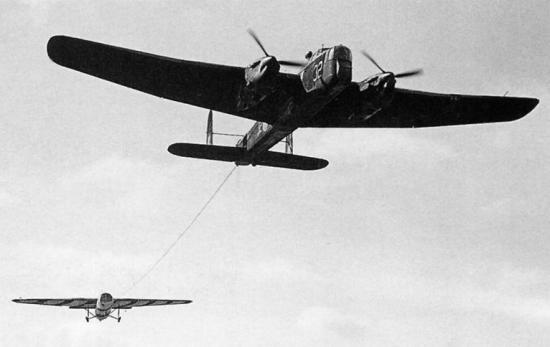
Armstrong Whitworth Whitley Mk V & Airspeed Horsa, Brize Norton, 1943
© unknown - source : Avia Deja Vu
Equipé d'un treuil à la place de sa tourelle arrière, le Whitley fut utilisé comme remorqueur de planeurs, notamment au sein de la No 21 Heavy Glider Conversion Unit (Brize Norton). Les premiers pilotes de planeurs furent entraînés au Glider Training Squadron sur des Hotspur tirés par des Hawker Hector et des Whitley. Le Hotspur étant trop petit pour les opérations, le Airspeed Horsa est développé : c'est un Whitley qui tractera le premier prototype du Horsa le 12 septembre 1941. En janvier 1942, les unités de planeurs sont réorganisées : le Glider Exercise Squadron devient le Squadron 296 et utilise des Hector et Withley, le Sqn 297 des Whitley.
Fitted with a winch instead of a rear turret, the Whitley was used to tow gliders, in particular in the No 21 Heavy Glider Conversion Unit (Brize Norton). The first glider pilots were trained to the Glider Training Squadron on Hotspur towed by Hawker Hectors and Whitleys. the Hotspur being too small to be operational, the Airspeed Horsa was developed : a Whitley towed the first prototype of Horsa on September 12th, 1941. In January, 1942, the units of gliders were reorganized : the Glider Exercise Squadron became Squadron 296 and used Hectors and Withleys, the Sqn 297 used Whitleys.

Armstrong Whitworth Whitley Mk V - 1943
Tracteur de planeur - Towing Glider
© Mikhail Bykov - source : http://wp.scn.ru
Ces deux unités sont regroupées à Hurn en mai 1942 où naîtra également en août le Squadron 295. L'ensemble formera le 38 Group. En 1942, ce 38 Group est équipé d'une soixantaine de Whitley Mk V GT (Glider Tow - Remorqueurs de planeurs). En 1944, ils seront remplacés par des Albemarle, Halifax ou Stirling mais seront utilisés pour l'entraînement dans des unités comme le 21 Heavy Glider Conversion Unit à Brize Norton où des pilotes de Hotspur se reconvertissent sur Horsa.
These two units were gathered at Hurn in May, 1942 where was also born in August the Squadron 295. All this formed the 38 Group. In 1942, this 38 Group was equipped with about sixty Whitleys Mk V GT (Glider Tow). In 1944, they were replaced by Albemarles, Halifaxs or Stirlings but were used for training in units such as 21 Heavy Glider Conversion Unit at Brize Norton where Hotspur pilots had to move on Horsa.
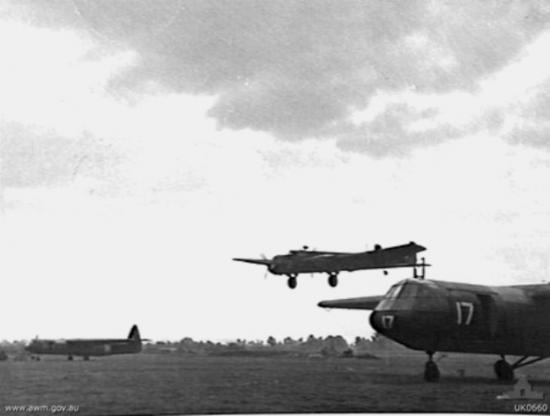
Armstrong Whitworth Whitley & Airspeed Horsa, Brize Norton, 1943
Public domain - Picture with courtesy of Australian War Memorial (http://www.awm.gov.au)
Transport :

Armstrong Whitworth Whitley Mk V - G-AGDY
Source inconnue - Source unknown
La B.O.A.C. (British Overseas Airways Corporation) utilisa 15 Whitley Mk V modifiés dans des missions de transport en 1942, notamment pour approvisionner Malte au départ de Gibraltar. Ils seront peints en vert et brun et auront une immatriculation civile. 12 de ces avions auront leur tourelles enlevées et recevront des réservoirs supplémentaires dans la soute à bombes : leur rayon d'action passera ainsi à 4023 km et 2270 kg de charge utile. En août 1942, ils furent remplacés par des Lockheed Hudson et les 14 appareils restant furent renvoyés à la R.A.F.
The B.O.A.C. ( British Overseas Airways Corporation) used 15 Whitleys Mk V modified for transport missions in 1942, especially to supply Malta from Gibraltar. They were painted in green and brown and had a civil registration. 12 of these planes had their turrets removed and received additional tanks in the bomb compartment : their range then passed at 4023 km and the payload at 2270 kg. In August, 1942, they were replaced by Lockheed Hudson and the 14 remaining aircrafts were sent back to the R.A.F.

© Mikhail Bykov - source : http://wp.scn.ru
Missions spéciales - Special duties
Le 21 août 1940, l'escadrille 419 Opérations Spéciales (419 Flight Special Duties), est créée pour transporter des agents en territoire occupé. 2 Whitley et 4 Lysander équiperont cette escadrille commandé par le F/Lt Farley. D'août à décembre, les Whitley effectueront 10 missions : 4 en France, 4 en Belgique et 2 aux Pays-Bas. Dans la nuit du 14 au 15 février 1941, le nouveau Squadron leader, le F/Lt Keast (qui remplace le F/Lt Farley, blessé aux commandes d'un Hurricane) conduit 3 agents polonais à Cracovie après un vol de 11h20. Dans la nuit du 17 au 18, pilotant le T4264, il est abattu et fait prisonnier avec son équipage en Belgique. Un autre Whitley du Sqn 78 sera affecté au 419 Flt mais sera détruit lors d'un atterissage. Fin mars 1941, le 419 Flt devient 1419 Flt (un 419 Sqn de la RCAF vient d'être créé). En juillet, les radio-phares portables Rebecca/Eurêka développés pour guider les Whitley vers les DZ sont expérimentés mais le Z6727 s'écrase lors d'essais à Newmarket (Suffolk). Le 25 août, le 1419 Flt devient Sqn 138 équipés alors de 10 Whitley.
On August 21st, 1940, the 419 Flight Special Duties was created to transport agents in occupied territory. 2 Whitleys and 4 Lysanders equipped this squadron led by the F/LT Farley. From August till December, Whitleys made 10 missions : 4 in France, 4 in Belgium and 2 in the Netherlands. During the night of the 14th to the 15th February, 1941, the new Squadron Leader, F/LT Keast (who replaced F/LT Farley, wounded when flying a Hurricane) led 3 Polish agents in Cracow after a 11h20mn flight. During the night of the 17th to the 18th, when flying the T4264, he was shot down and arrested with his crew in Belgium. Another Whitley of Sqn 78 was allocated to the 419 Flt but was destroyed when landing. Late March, 1941, the 419 Flt became 1419 Flt (a 419 Sqn of the RCAF had just been created). In July, the portable radio-beacons Rebecca /Eurêka created to guide Whitleys towards the DZ were experimented but the Z6727 crashed during tests at Newmarket (Suffolk). On 25th August, the 1419 Flt became Sqn 138 equipped with 10 Whitleys.
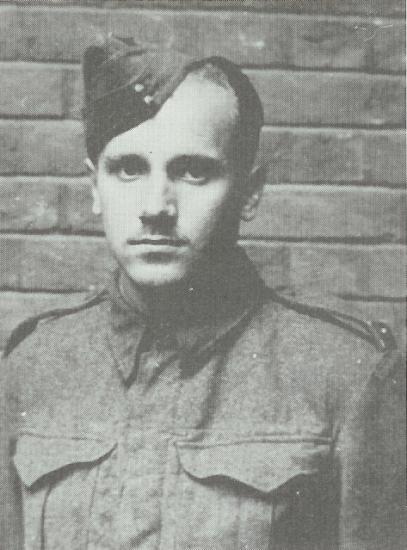
Frantisej Pavelka (29.11.1920 – 11.1.1943)
Largué depuis le Whitley Z9158 début octobre 1941
Dropped from the Whitley Z9158 in early October, 1941
Source inconnue - Source unknown
De nombreuses missions s'enchaîneront : la plus longue mission réalisée par un Whitley fut effectuée par le Whitley Z9158 (F/O Hockey - P/O Wilkin) dans la nuit du 3 au 4 octobre 1941. L'appareil decolla de Tangmere pour larguer le radio Tchèque Frantisek Pavelka à Pardubice (Tchécoslovaquie) : durée de la mission 11h 25mn. Dans la nuit du 27 au 28 décembre 1941, un Whitley effectue un bombardement sur le Danemark puis largue 3 agents : seulement 2 parachutes s'ouvriront. Mi 1942, le SOE perd la liaison avec les résistants Danois qui veulent éviter les représailles sur les civils. Le SOE décide donc de larguer ses agents dans l'eau : ainsi, l'agent Morgans Hammers sera largué par un Whitley dans la nuit du 18 au 19 octobre 1942 dans le détroit qui ferme la Baltique.
Various missions followed : the longest mission operated by a Whitley was made by the Whitley Z9158 (F/O Hockey - P/O Wilkin) during the night of the 3rd to the 4th October, 1941. The aircraf took off from Tangmere to drop the Czech radio Frantisek Pavelka at Pardubice (Czechoslovakia): duration of the mission 11 hours 25mn. In the night of 27th to 28th December 1941, a Whitley made a bombardment on Denmark and then dropped 3 agents : only 2 parachutes opened. Mid-1942, the SOE lost the connection with the Danish resistants who wanted to avoid reprisals on civilians. The SOE thus decided to drop the agents in the water : the agent Morgans Hammers was dropped by a Whitley in the night from 18th to 19th October 1942 in the strait of the Baltic Sea.
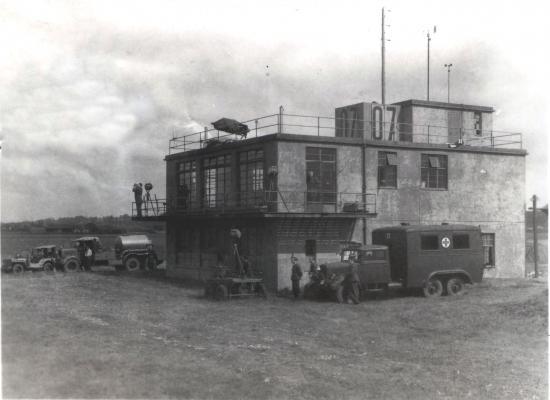
Tempford RAF base © Peter Haining - source : Wikimedia Commons
En décembre 1941, le Sqn 138 possède 12 Whitley. En février 1942, le Sqn 161 est formé à Newmarket. 5 Whitley lui sont affectés (Flight B). Au printemps, les 2 Squadrons sont regroupés à Tempsford (Bedfordshire). Dans la nuit du 1er au 2 avril 1942, un Whitley (Ft/Sgt Peterson) effectue la première mission (appelée "Mackerel") du Sqn 161 et largue 3 agents du BCRA en France. Dans la nuit du 22 au 23 novembre 1942, 1 des 5 Whitley du Sqn 161 envoyés en mission en Belgique ne rentre pas : cet appareil (s/n Z6629 - code MA-N) sera le dernier Whitley perdu en 1942 sur un total pour l'année de 19 Whitleys détruits (en plus de 3 Lysander et 8 Halifax). Le Sqn 161 effectuera le 22 février 1943 la dernière mission de Whitley avec un appareil du Sqn 502 (Coastal Command).
In December, 1941, the Sqn 138 had 12 Whitleys. In February, 1942, the Sqn 161 is formed at Newmarket. 5 Whitleys were allocated to it (Flight B). In Spring, both Squadrons were gathered at Tempsford (Bedfordshire). During the night of 1st to 2nd April 1942, a Whitley (Ft/Sgt Peterson) made the first mission (called "Mackerel") of Sqn 161 and dropped 3 agents of the BCRA in France. During the night of 22nd to 23rd November 1942, 1 of the 5 Whitleys of Sqn 161 sent in mission in Belgium did not return : this aircraft (s/n Z6629 - code MA-N) was the last Whitley lost in 1942 out of 19 destroyed during the year (in addition to 3 Lysanders and 8 Halifaxes). The Sqn 161 made on February 22nd, 1943 the last mission of a Whitley with an aircraft of Sqn 502 (Coastal Command).
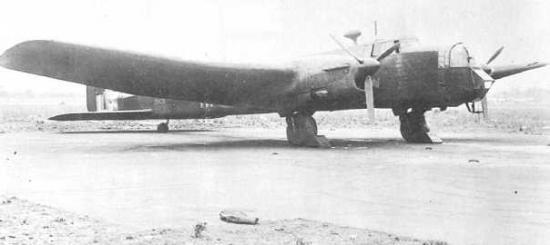
Armstrong Whitworth Whitley Mk V - 138 Sqn
Source inconnue - Source unknown
Les Whitley et la résistance française - The Whitleys and the french resistance
En août 1940, un premier parachutage (419 Flt) est effectué sur Paris pour le compte du SIS. Puis les missions s'enchaînent : Philippe Schneidau saute sur Fontainebleau le 9 octobre. La première mission pour la section française du SOE a lieu le 5 mai 1941 : c'est l'opération "Bombproof" au cours de laquelle le S/Ldr Knowles parachute le radio Pierre Bégué (alias "Georges") au nord de Châteauroux. Suite à un message radio de Bégué, Knowles parachutera 5 jours plus tard "Lucas" (Pierre de Vomécourt) et "Bernard" (Emmanuel d'Astier de la Vigerie ou Louis Lefrou de la Colonge selon les sources) dans la même région (opération Autogiro D et E) ; au retour de cette mission, le mitrailleur arrière abat un Me Bf 110 au dessus du Mans. Dans la nuit du 12 au 13 juin 1941, le Sgt Austin larguera un conteneur à proximité du château de Philippe de Vomécourt, frère de Pierre, près de Limoges.
In August, 1940, a first parachute drop (419 Flt) was made over Paris for the SIS. Then missions followed : Philippe Schneidau jumped over Fontainebleau on October 9th. The first mission for the French section of the SOE happened on May 5th, 1941 : it was the operation " Bombproof " during which the S/Ldr Knowles parachuted the radio Pierre Bégué (alias "Georges") in the North of Châteauroux. Further to a radio message of Bégué, Knowles parachuted 5 days later "Lucas" (Pierre de Vomécourt) and "Bernard" (Emmanuel d' Astier de la Vigerie or Louis Lefrou de la Colonge according to sources) in the same region (operation Autogiro D and E); when returning from this mission, the rear machine gunner shot down a Me Bf 110 over Le Mans (France). During the night of the 12th to the 13th June 1941, the Sgt Austin dropped a container near the castle of Philippe de Vomécourt, Pierre's brother, near Limoges.
La section F organise début juillet l'opération "Torture" : le S/Ldr Knowles largue J.L. Cartigny et H. Labit pour une mission de sabotage sur la base de Caen-Carpiquet. J.L. Cartigny est capturé et fusillé. H. Labit gagne Toulouse et fonde le réseau "Fabuleux". Il se suicidera en avril 1943. Dans la nuit du 13 au 14 octobre 1941, le S/Ldr Murphy parachute le Lt Forman et un opérateur radio près de Toulouse pour aider Labit à préparer l'opération "Mainmast" qui sera effectuée le 1 janvier au soir : le Sgt Jones à bord d'un Whitley du Sqn 138 parti de St Eval largue dans la région de l'embouchure du Rhône Jean Moulin et deux autres hommes ; il retournera à St Eval après 11h 57mn de vol !
The section F organized in early July the operation "Torture" : the S/Ldr Knowles dropped J.L. Cartigny and H. Labit for a mission of sabotage on the Caen-Carpiquet base. J.L. Cartigny was captured and shot. H. Labit reached Toulouse and created the network "Fabuleux". He committed suicide in April, 1943. In the night from 13th to 14th October 1941, the S/Ldr Murphy parachuted the Lt Forman and a radio operator near Toulouse to help Labit to prepare the operation "Mainmast" which was made on January 1st in the evening : Sgt Jones aboard a Whitley of Sqn 138 from St Eval dropped in the region of the Rhône Jean Moulin and two other men ; he returned to St Eval after a 11 hours 57mn flight !
Dans la nuit du 3 au 4 mars 1942, un Whitley du Sqn 138 piloté par la P/O Anderle, largue en France 3 agents du NKVD (chargés de surveiller les organisations communistes) dont la première femme larguée en France : Anna Frolova alias Francine Fromont alias Annette Fauberge. Les deux autres agents étaient Grigory Rodionov alias Georges Robigot et Ivan Danilov alias Pierre Dandin. Les missions continuent courant 1942 et début 1943, les Halifax remplacent les Whitley.
In the night from 3rd to 4th March 1942, a Whitley of Sqn 138 flown by the P/O Anderle, dropped in France 3 agents of the NKVD (in charge of watching the communist organizations) of whom the first woman dropped in France : Anna Frolova alias Francine Fromont alias Annette Fauberge. The two other agents were Grigory Rodionov alias Georges Robigot and Ivan Danilov alias Pierre Dandin. The missions continued in the year 1942 and in early 1943, Halifaxes replaced the Whitleys.
Englandspiel aux Pays-Bas - Englandspiel in the Netherlands
De 1941 à 1943, une opération d'intoxication organisée par l'Abwehr III/F en Hollande, appelée "Englandspiel", va permettre aux Allemands d'arrêter de nombreux agents et d'abattre quelques Whitley. Le Whitley serial T4166 est abattu fin février (ou début mars) près de l'île de Texel après avoir parachuté le Lt Baasten (capturé et déporté). Dans la nuit du 29 au 30 juillet 1942, le Whitley Mk V serial Z9230 code NF-N est abattu par le Lt August Geiger à bord de son Me Bf 110 ; l'équipage sera tué (S/L William Twiston Davies - pilote, F/Sgt Leonard Sidney Franklin, F/Sgt Trevor Morgan Gray, Sgt Edward Henry Kerry, Sgt Derrick Frank Staton, Sgt Geoffrey Barrington Wood, Sgt Philip Thomas).
From 1941 till 1943, an operation of poisoning organized by the Abwehr III/F in Holland, called "Englandspiel", allowed the Germans to arrest many agents and to shoot down some Whitleys. The Whitley serial T4166 was shot down late February (or early March) near the island of Texel after having parachuted Lt Baasten (captured and deported). In the night from 29th to 30th July 1942, the Whitley Mk V s/n Z9230 code NF-N was shot down by the Lt August Geiger aboard his Me Bf 110 ; the crew was killed (S/L William Twiston Davies - pilot, F/Sgt Leonard Sidney Franklin, F/Sgt Trevor Morgan Gray, Sgt Edward Henry Kerry, Sgt Derrick Frank Staton, Sgt Geoffrey Barrington Wood, Sgt Philip Thomas).
Les unités - The units
